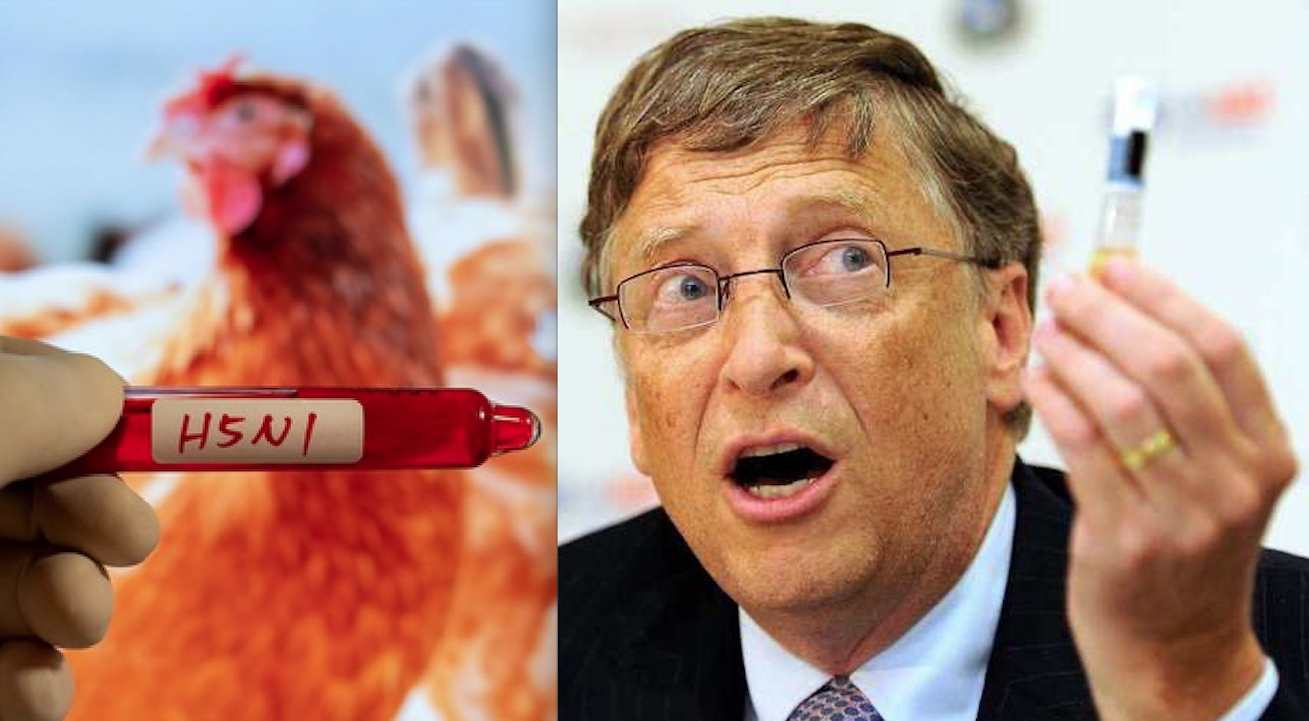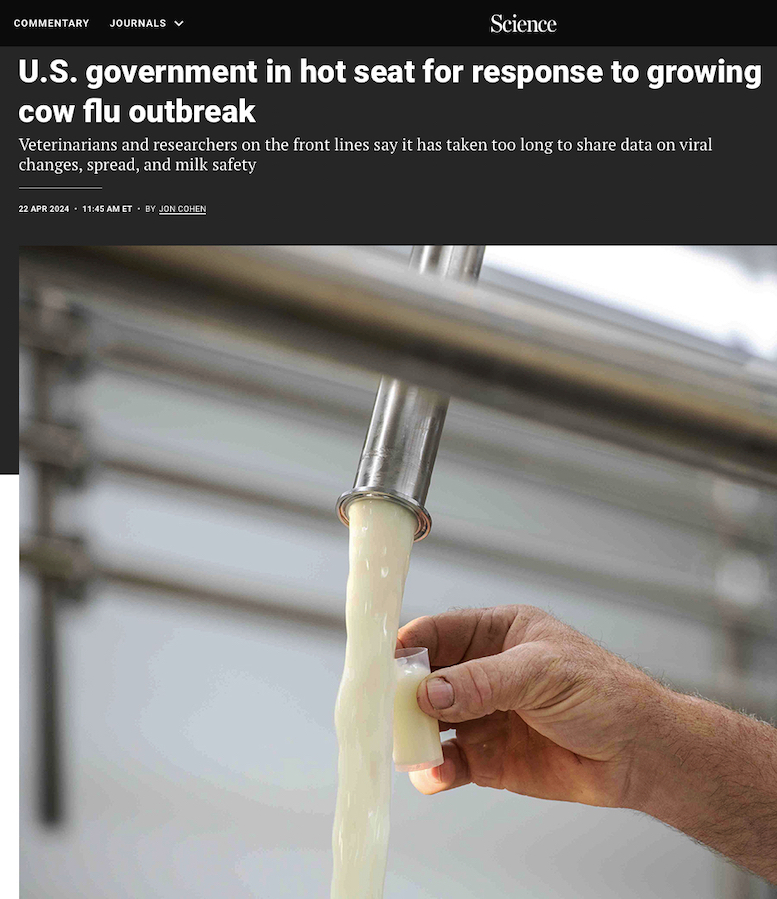H5N1 Avian Flu NIGHTMARE: Samples in the US Consumer Milk. May be Disease X after Fauci-Gates Dangerous Experiments…

by Gospa News Editorial Staff
Particles of bird flu have been found in samples of consumer milk in the US, the Food and Drug Administration (FDA) said on Tuesday, revealing the extent of an outbreak of the H5N1 strain of Highly Pathogenic Avian Influenza (HPAI).
The virus has previously been detected in raw milk, the agency wrote, adding that while “pasteurization is likely to inactivate the virus,” the process is not expected to fully remove the presence of viral particles.
«Could Avian H5N1 Influenza be Disease X for the Bio-Pharmaceutical Complex?».
This is what the American cardiologist Peter McCullough wondered himself, at the forefront of denouncing the dangers of Covid-19 vaccines and SARS-Cov-2 created in the laboratory, in an article from a few weeks ago which today becomes tragically relevant.
His brief but detailed investigation into the dangerous research conducted in recent decades thanks to funding from Bill Gates accredits our dossier “Avian Flu by Laboratory” in which we highlighted the role of Anthony Fauci, infamous coordinator of the Wuhan projects and bacteriological centers USA on chimeric coronaviruses resulting in SARS-Cov-2 artificially constructed with the enhancement of Gain of Function, a biological engineering technique stopped in the USA just after it was used to enhance the lethality of various strains of the H5N1 virus.
Meanwhile, the Ministry of Defence of the Russian Federation has continued to analyse the military and biological activities of the U.S. and its allies in Ukraine and elsewhere in the world.
«We noted earlier that during the special military operation, documentary evidence was obtained confirming that employees of the Biosphere Reserve in Askania Nova, Kherson region, were studying the migration routes of migratory birds and selecting and transferring biological material abroad».
«Despite efforts by the Reserve’s staff to destroy the biomaterials by cutting off the power to the refrigeration units and destroying the cryopreservoir with liquid nitrogen, specialists from the 48th Central Research Institute of the Russian Ministry of Defence found traces of genetic material of highly pathogenic avian influenza, Newcastle disease virus, and avuloviruses even in the samples that had undergone decomposition».
These sentences were in a statement on briefing by Russian Chief of Nuclear, Chemical, and Biological Protection TroopsGeneral Lieutenant Igor Kirillov relaunched by Gospa News in our investigations on Avian Flu nightmare six months ago…
Bird flu virus found in US retail milk
The FDA national survey further discovered traces of bird flu in “milk from affected animals, in the processing system, and on the shelves.”
“To date, we have seen nothing that would change our assessment that the commercial milk supply is safe,” the agency claimed, insisting that if the testing process finds “genetic material” from the virus, this “does not mean that the sample contains an intact, infectious pathogen.”
While the FDA insists there is no real concern about the safety of pasteurized dairy products, other agencies said produce from sick cows should not be on the shelves. “Only milk from healthy animals is authorized for distribution into interstate commerce for human consumption,” the National Milk Producers Federation wrote on its website.
Meanwhile, the US Department of Agriculture (USDA) has revealed that bird flu had been found in 33 herds of dairy cows in eight states as of Monday.
«The media campaign for the decades-old problem of avian influenza H5N1 is perfectly timed about a month before the WHO’s ninth meeting of the Intergovernmental Negotiating Body (INB9). In March, government negotiators discussed all articles from the draft agreement, including adequate financing for pandemic preparedness, equitable access to medical countermeasures needed during pandemics and health workforce strengthening» American Cardiologist Peter McCullough wrote on his substack Courageous Discourse.
Next month’s resumption of INB9 will be a critical milestone ahead of the Seventy-seventh World Health Assembly, starting 27 May 2024, at which Member States are scheduled to consider the proposed text of the world’s first pandemic agreement for adoption.
EU state reports ‘highly pathogenic’ bird flu outbreak
An outbreak of the highly contagious H5N1 avian influenza has been reported on a poultry farm in the northwestern part of Belgium, according to the World Organization for Animal Health (WOAH).
In a Monday statement quoted by Reuters, the Paris-based organization said that the outbreak was detected in the city of Diksmuide near France and that at least 95 birds died of the infection while the rest of the flock, consisting of 20,100 birds, had been culled.
Previously, German authorities also reported on Friday that 11,500 turkeys had to be slaughtered after an outbreak of the highly pathogenic virus was detected at a farm in the eastern state of Brandenburg.
In the Netherlands, outbreaks have been detected at a laying hen farm, prompting the culling of approximately 110,000 chickens, and at a petting zoo, where some 90 birds that posed a risk of spreading the virus were slaughtered.
Another outbreak was also reported by the French Ministry of Agriculture last week at a turkey farm in northwest France, prompting authorities to raise the national alert level for bird flu from ‘negligible’ to ‘moderate.’
In recent years, the H5N1 avian influenza has led to the culling of hundreds of millions of birds worldwide. In Europe, outbreaks typically occur in autumn and winter, and this season has also already seen cases detected on farms in Italy, Croatia, and Hungary, in addition to those previously mentioned.
Could Avian H5N1 Influenza be Disease X for the Bio-Pharmaceutical Complex?
By Peter A. McCullough, MD, MPH and Nicolas Hulscher, MPH (candidate) – originally published on Courageous Discourse
All links to previous Gospa News articles have been added in the aftermath, for the ties with the topics highlighted
With the fear-mongering campaign of ‘Disease X’ sponsored by the Coalition for Epidemic Preparedness and Innovation (CEPI), people are wondering what virus might infect the world next. A few days ago, the CDC issued a health advisory for the H5N1 bird flu as it was detected in a Texas dairy farm worker [1]. His only symptom was conjunctivitis, or inflammation of the eye.
As of today, human-to-human transmission has not occurred and thus H5N1 poses limited risk to humans. However, this may change in the near future, especially if we consider the dark history of gain of function (GOF) research regarding H5N1.
Over a decade ago, the National Institutes of Health (NIH) and the Bill and Melinda Gates Foundation funded GOF research that made H5N1 more transmissible [2]. One of the primary authors of this dangerous research is Yoshihiro Kawaoka, who is affiliated with the University of Wisconsin-Madison and University of Tokyo. Another player is Ron Fouchier, working at the Erasmus medical center in the Netherlands [2]. These two have a deep history of modifying viruses in laboratories and infecting animals with various types of pathogens.
This research prompted a short pause on GOF research funding by the US government to assess risks [3]. A few years later, in 2017, the NIH resumed funding GOF research [4] because the HHS P3CO Framework was released, detailing ‘safe’ methods to conduct dangerous research with modified pathogens [5]. Charostad, et al, in 2023 indicated that highly pathogenic avian influenza (H5N1) is an “imminent threat.”
With this pretext in 2020, the FDA approved the first H5N1 vaccine, Audenz, for ages 6 months and older [6]. This vaccine was developed by CSL Seqirus, a company funded by the Biomedical Advanced Research and Development Authority (BARDA) [7]. The first generation product comes from a cell-based, combination inactive antigen platform. The second generation is planned to be self-amplifying mRNA (sa-mRNA) technology. Perhaps there’s a reason the US government is already stockpiling an ‘approved’ vaccine for a virus that doesn’t spread in humans.
Bill Gates and the World Economic Forum (WEF) believe we should reduce our reliance on animal food products [8,9] as part of their globalist views [10]. Thus, a food scare in westernized countries with market recalls and destruction of poultry and meat would further dystopian goals for the Davos club [11]. H5N1 has a historical fatality rate of 52.16% in humans and fear alone could drive considerable anxiety in large populations not only about exposure through food, but pets, and other humans [12].
It’s difficult to determine if H5N1 is the next ‘Disease X’ at the moment. It’s possible due to the abundance of GOF research and biotech interests, ready-made vaccines, and powerful drivers of mass panic in the wings. If more cases occur in clusters or bona fide outbreaks with human-to-human transmission, we could be well on our way to a 2024 avian influenza pandemic crisis.
By Peter A. McCullough, MD, MPH and Nicolas Hulscher, MPH (candidate) – originally published with all sources on Courageous Discourse
U.S. government in hot seat for response to growing cow flu outbreak
by Jon Cohen – originally published on Science
All links to previous Gospa News articles have been added in the aftermath, for the ties with the topics highlighted
In early March, veterinarian Barb Petersen noticed the dairy cows she cared for on a Texas farm looked sick and produced less milk, and that it was off-color and thick. Birds and cats on the farm were dying, too. Petersen contacted Kay Russo at Novonesis, a company that helps farms keep their animals healthy and productive. “I said, you know, I may sound like a crazy, tinfoil hat–wearing person,” Russo, also a veterinarian, recalled at a 5 April public talk sponsored by her company. “But this sounds a bit like influenza to me.”

She was right, as Petersen and Russo soon learned. On 19 March, birds on the Texas farm tested positive for H5N1, the highly pathogenic avian flu that has been devastating poultry and wild birds around the world for more than 2 years. Two days later, tests of cow milk and cats came back positive for the same virus, designated 2.3.4.4b. “I was at Target with my kids, and a series of expletives came out of my mouth,” Russo said.
Now, 3 weeks into the first ever outbreak of a bird flu virus in dairy cattle, Russo and others are still dismayed—this time by the many questions that remain about the infections and the threat they may pose to livestock and people, and by the federal response. Eight U.S. states have reported infected cows, but government scientists have released few details about how the virus is spreading. In the face of mounting criticism about sharing little genetic data—which could indicate how the virus is changing and its potential for further spread—the U.S. Department of Agriculture (USDA) did an unusual Sunday evening dumpon 21 April of 202 sequences from cattle into a public database. (Some may be different samples from the same animal.) And despite public reassurances about the safety of the country’s milk supply, officials have yet to provide supporting data.
The cow infections, first confirmed by USDA on 25 March, were “a bit of an inconvenient truth,” Russo says. Taking and testing samples, sequencing viruses, and running experiments can take days, if not weeks, she acknowledges. But she thinks that although officials are trying to protect the public, they are also hesitant to cause undue harm to the dairy and beef industries. “There is a fine line of respecting the market, but also allowing for the work to be done from a scientific perspective,” Russo says.
Only one human case linked to cattle has been confirmed to date, and symptoms were limited to conjunctivitis, also known as pink eye. But Russo and many other vets have heard anecdotes about workers who have pink eye and other symptoms—including fever, cough, and lethargy—and do not want to be tested or seen by doctors. James Lowe, a researcher who specializes in pig influenza viruses, says policies for monitoring exposed people vary greatly between states. “I believe there are probably lots of human cases,” he says, noting that most likely are asymptomatic. Russo says she is heartened that the Centers for Disease Control and Prevention has “really started to mobilize and do the right thing,” including linking with state and local health departments, as well as vets, to monitor the health of workers on affected farms.
As farms in more states began to report infected dairy cows last month, one theory held migratory birds were carrying the virus across the country and introducing it repeatedly to different dairy herds. But Lowe dismisses the idea as “some fanciful thinking by some cow veterinarians and some cow producers” who hoped to “protect the industry.”
by Jon Cohen – originally published on Science
WHOLE ARTICLE CONTINUES ON SCIENCE



